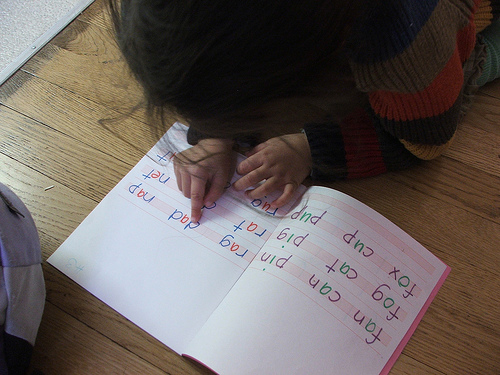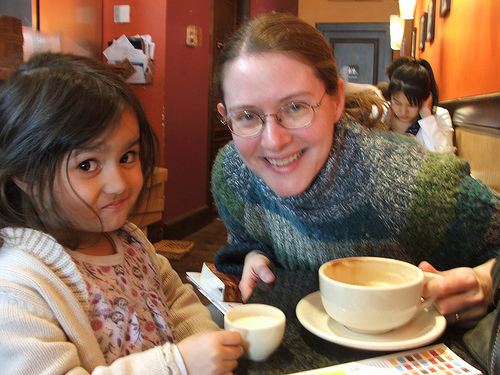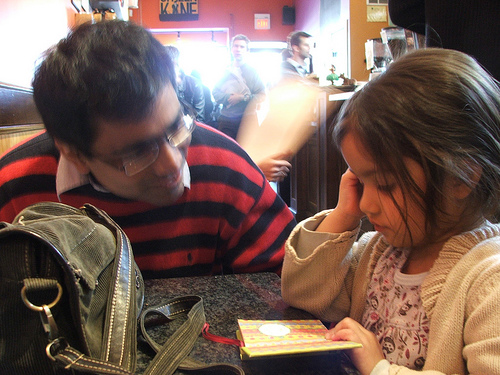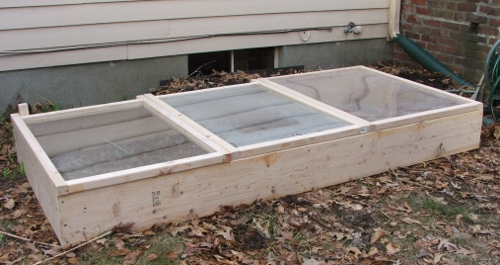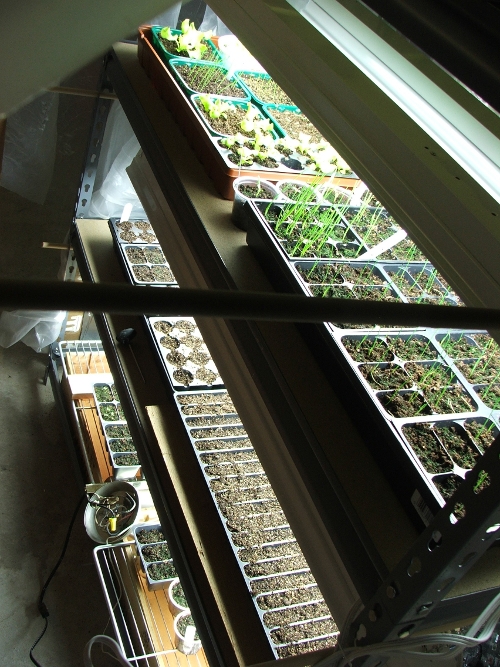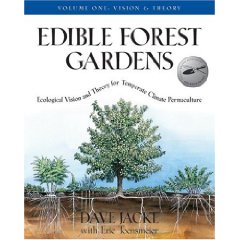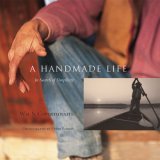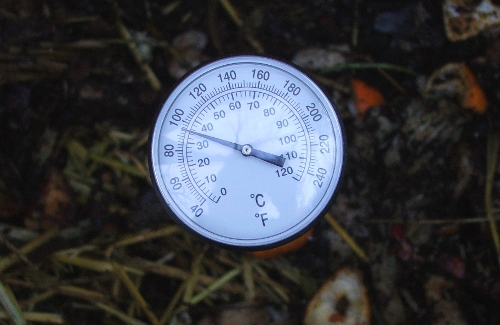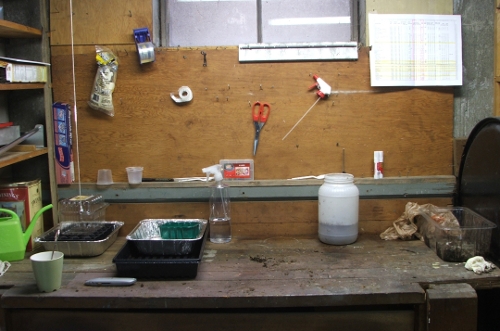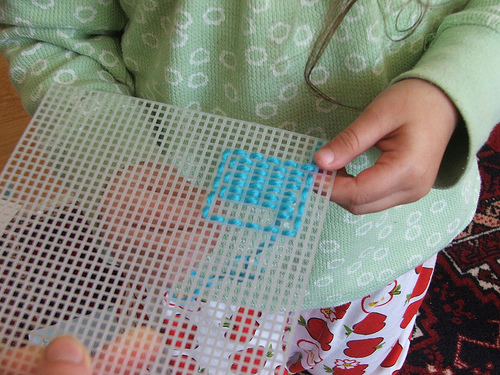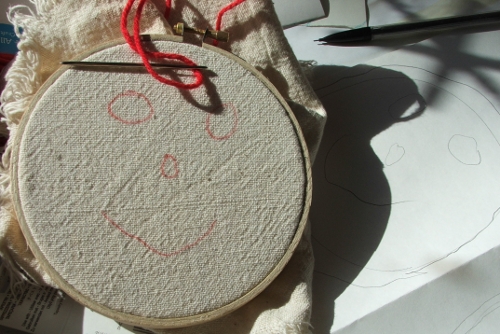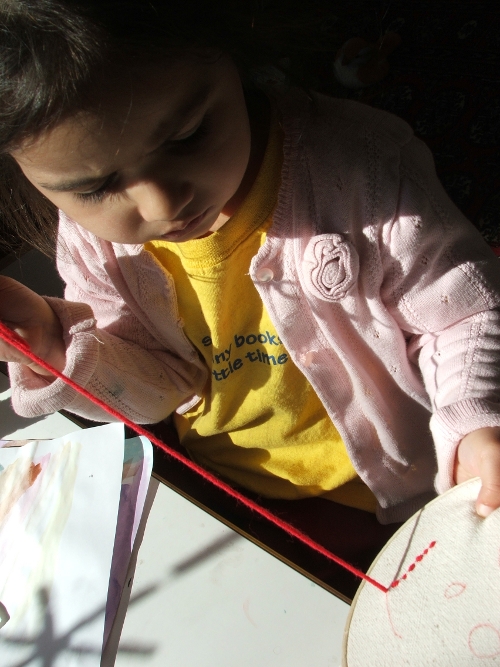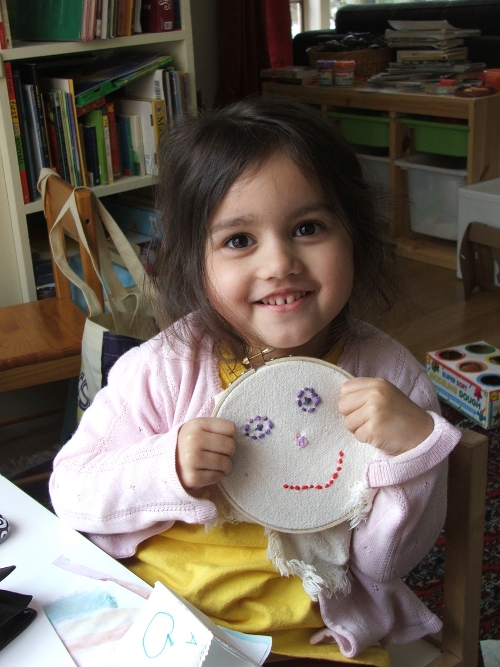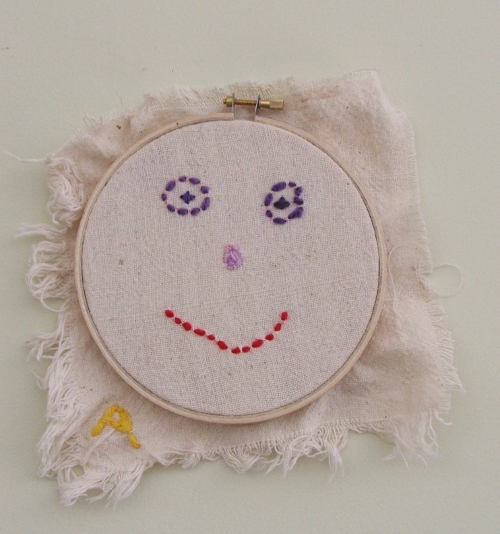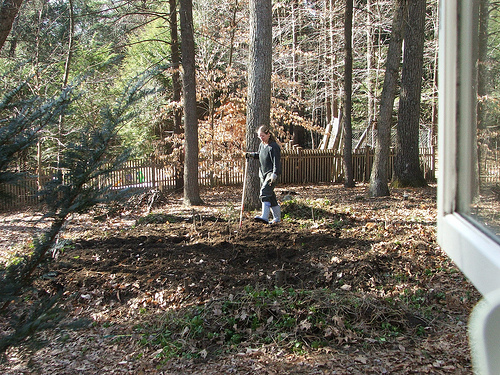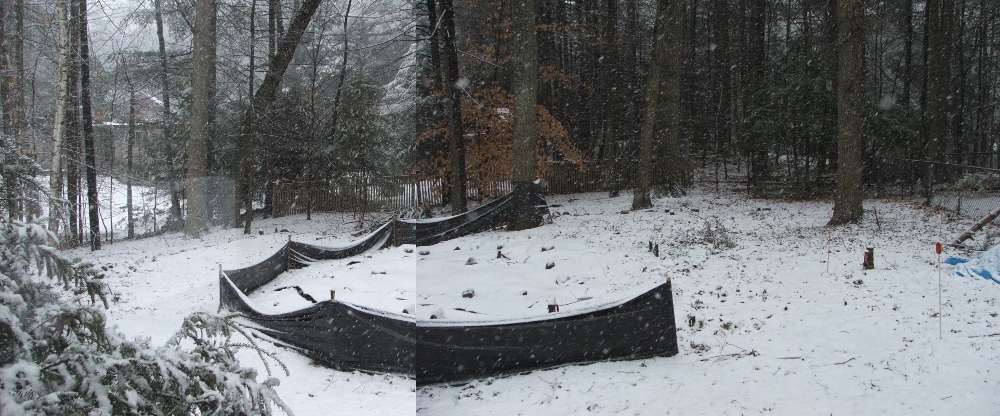Without words… except for fan, can, pin, rag…
Ode to Last Weekend
Last Saturday we had a big dinner with a whole bunch of friends and one of them even stayed over! Oh, I love having people stay over, especially the kind of friend you sit and chat with, after the dishes are done, until midnight…
Sunday warm (“heated up,” even, relatively) as we drove “into town” to drop her off at her place. It was the kind of day that used to be an average day: bookshop, visit with friends, coffee shop. But for us, now, it was out of the ordinary and extra special for that.
Our visit to the Brookline Booksmith ended in too much money being spent, but on books, you know, half of them secondhand, and we’ve been so thrifty, and there were presents for someone else – Henry the Incredible Book Eating Boy by Oliver Jeffers – and poetry (Donald Hall) and one more Rick Bass for my collection, and Barbara Damrosch’s Garden Primer for a steep discount… So perfectly excusable.
We had a lovely visit with dear friends who just had a second baby daughter. We sat and chatted while the baby slept and Amie and her pal played. Afterwards we got in the car with the intention of driving home, but we happened past Simon’s CoffeeShop in Cambridge and DH – a coffee snob – wanted to try their famed espresso. So there we were, the three of us, enjoying our cups – some big, some small.
And reading our books, chatting… So lovely, the three of us together!
On the way home there was this:
And then a quick peek at Walden Pond, where people were still walking on the ice, although it was int eh sixties. Once home there was chatting with neighbors on the street, and swatting at mosquitoes already, while Amie and Baba went for a bikeride. They came home after the sun had (just) set…
Cold Frame (almost) Installed
Finally an outdoor garden photo!
The construction of the cold frame is done and we placed it in front of our house to the south and at the top of a slope. That place gets optimal sunlight during the winter, but not much during the summer, as it will be shaded for most of the day. That’s not a problem, since this will be our frame for hardening off in spring and summer and for harvesting in winter and spring.
It’s almost 4′ by 8′ by 10″ and made of Douglas Fir boards and Freecycled storm windows (two made of glass and one – mercifully the biggest one – of plexi-glass). It’s based on Eliot Coleman’s design.
We’ll be fiddling around with it. For instance, we might add some heights in the back to give it some more height there (12″) and thus a slight slope toward the sun (Coleman doesn’t think this is necessary, so we’ve foregone it so far).
But we’re especially concerned with how to optimally open the “lights” (windows) for planting and harvesting. There are no hinges at the moment (keeping it as simple as possible), so it’s a “tilt/lift off” system that might not work with lights this large. We also still need to make a notched plank for propping the lights open for ventilation. I can see inside the frame from our bathroom window, and we’ll be adding a remote sensing thermometer, but having one of those solar powered vent openers will give peace of mind.
We’re not ready to go of course because… there is no soil in it yet! The soil underneath in will need to be dug out and some drainage needs to be laid at the bottom (gravel). We’ll remove the bulbs, grass, moss and weeds from the soil, add soil amendments and compost, and fill up the pit again so the soil will sit higher than at first. I need to do some research as to how deep we’ll have to dig.
So I will have to decide whether that‘s where I want it, soon. As you can see there are gutter spouts on either side of it, and we’ll want to harvest that rain, so we’ll need to ensure that there will be enough space for barrels. Another consideration is that that’s the only free south-facing wall where we could put an espaldiered apple tree, Or a solar thermal collector…
DH will be away for business for a week, during which I can think these factors over and observe the temperatures and light in the frame, and our garden critters’ reactions to it.
I’m just happy it’s out there. I want to be out there too!
Bottom Heat for Germination
The growing rack is filling up. The bottom shelf is now exclusively a “hot box”, where the most heat-loving seeds go to germinate. Yesterday I added three kinds of basil (Tulsi or sacred basil, Genovese and sweet Italian) and greek oregano to the already resident eggplant, peppers, parsley and rosemary.
The second shelf is the medium temperature germination area (around 60-65F), where I added scallions, more garlic chives, rue, sage and lemon balm to the onions, leeks, chives and thyme and burnet, among others.
The third shelf is the seedling area with some room for seeds that like it cold for germination, like borage (around 55F).
I fiddled around with many way to give the heat-loving seeds their desired temperature. I ruined most of the first batch of eggplant seeds by placing them underneath an incandescent bulb: they got dried out, then I watered them, then they dried out again, etc.
Bottom heat is of course the best, I knew that. The electric heatmats that can supply it most evenly are $30 for one the size of one flat (10×20″) and $40 for one the size of two flats (20 x 20″, which is the kind of real estate I need at the moment). And that is without thermostat.
But first I wanted to build something myself. After some experimentation – during which I nearly cooked some seeds – I came up with this:
I used a double spotlight (part of the previous owner’s decor), with two incandescent bulbs and maneuvered each into a wooden wine case (came with the canning jars I got on Freecycle). On top of the boxes I placed two metal fridge racks (picked up at the landfill). The plugs and pots go right on top of those.
The temperature is of course not evenly divided, but that’s good. The soil in the pots right on top of the lamps is hotetst: 80F, perfect for peppers and eggplant. The pots more off center are about 70F and the ones to the side are 67F or so. It makes for some fun puzzling. The available area isn’t quite two flats, but close.
My only concern is the energy consumption. Those two lamps use 120 W. A heatmat consumes very little: about 45 W (for the 20×20″ one). The lamps are ineffecient: if they’re on for a month (and I keep them on at night), then they’ll consume 108 KWH {UPDATE} sorry, miscalculated: it’s really 86.4 KWH. The heatmats would make for only 32.4 KWH… To be continued.
Edible Forest Gardens: Bought it After All
Just last week I wrote that I was thinking of purchasing Edible Forest Gardens by Jacke and Toensmeier, but that it was too expensive. Luck and generosity came my way so I could buy it anyway. Amie really got to see how happy books can make her, when the mailman brought the big box (2 big volumes) to the door.
Just to let you know…
Coperthwaite, A Handmade Life, Review Part 1
Here’s another article I wrote for Suite101.com, the copyright of which passed to me so I can share it with you here.
It’s of William S. Coperthwaite’s book A Handmade Life, In Search for Simplicity. It was one of the first books I read after making my turn-around regarding a Simpler Life in a Better Future, and it influenced me tremendously. I reread this book every few months now (it’s not too long and has some beautiful photographs). Rereading it is a great grounding experience for me.
I wrote a couple of reviews of it and this one was the general review.
- The author
The author of A Handmade Life, In Search for Simplicity, William Coperthwaite, is a philosopher and anthropologist, and a designer of social as well as material constructions. He is a scholar – he has a Ph.D. in education from Harvard – and a teacher, albeit an unorthodox one. But he is foremost a physical kind of man, a skilled craftsman who built his own home and chops his own wood at his homestead in Maine, most accessible by canoe.
Though Coperthwaite lives “off the grid†– buying almost nothing, reachable only via mail to the local library – his sustainable living experiment is not an “exit strategyâ€. He welcomes visitors, travels to learn from other cultures, and is available for lectures and yurt-building workshops.
And of course he reaches out to all of us in his book, A Handmade Life, published by Chelsea Green in 2002 and newly out in paperback.
- The Democratic Axe (and Chair)
A Handmade Life has something of everything, but most importantly, it has hope. Though there is critical and honest analysis of a world in crisis, this is not a doomsday book. It has recipes for a better community – of humans and nature – that Coperthwaite himself has put to the test in over four decades.
“My central concern is encouragement,†he writes. He is reluctant to be called a teacher, but it is true that his most inspired writing evolves from his desire to better our lives. Still, like the best of teachers, he gently offers us the skills and tools for making better lives ourselves.
This he calls “democratic†and it is his greatest gift to us: the message that a fulfilling life is up to each of us – not big corporations, big government – and that we can do it.
But do what? Preserve not things but the skills to make things, and the skills to make the tools to make things. And work. With those we can emancipate ourselves from machinery, mindless consumption, and unhealthy, unnatural and asocial lifestyles.
- Hand–made
This brings us to the keyword in the book’s title: Handmade. A “handmade life†is centered on “bread workâ€, that is, physical labor. Sounds unappetizing? Coperthwaite is convincing when he pleads for reintroducing work into our lives and even the lives of our children, and promises that it is the only foundation for a healthy body and a happy mind.
Thus the book seamlessly combines philosophy and reflection with how-to-build inserts on “The Democratic Axeâ€, “The Democratic Chair†and handmade toys. And let’s not forget the “Democratic Houseâ€: the yurt. It is a house you can build yourself, with your hands, at a small cost to your wallet and to nature. It is beautiful and long-lasting, as are all the tools, objects and lives that Coperthwaite promotes.
That said, this most inspiring heart of Coperthwaite’s work is also his weakest spot. In his desire to promote it, he can’t help but generalize the individual handmade life to a social level. In this he is less convincing. In the sections on the social distribution of work and pay, for instance, the book loses its marvelous exemplary quality and slips into abstract, redundant theorizing. Such social theorizing or “designing,†as Coperthwaite calls it, is out of place in this book. Luckily there are only few such lapses.
- A simple beauty
The beauty of A Handmade Life lies in simplicity as its subject, method and presentation. Coperthwaite is a man of words both small – “I want to live in such a way that small gifts are meaningful†– and big – “We need poets who can discover and proclaim the beauty of simplicity while themselves living a simple, rural life of creative and honest laborâ€. But he makes sure that both kinds are democratic words that all of us can choose to use and apply to ourselves.
Peter Forbes’ stunning photographs documents Coperthwaite’s life and desire: a couple of hand-carved, curved spoons, Coperthwaite carrying a toddler, guiding his canoe.
Those interested in the Simple Life of Helen and Scott Nearing and the teachings of non-violence of Richard Bartlett Gregg will find Coperthwaite a thoughtful interpreter.
Sections of this book appeared in Manas and Mother Earth News. It is printed on recycled paper.
What’s Cooking
Compost bin 1 at 92 degrees F
In the Germination Area
- sowed second batch of Onions, Leeks, Catnip
- sowed first batch of Garlic Chives
- 2 Rosemary sprouts emerged
- 1 Parsley sprout
- 15 Sweet Marjoram
- 15 Thyme
- 3 tiny Mint sprouts
- 1 Lemon Balm sprout (but it’s probably a stray Marjoram)
- 1 Pepper seedling (looks stuck in the soil, not raising its head)
- nothing happening yet among the Wormwood, Anise Hyssop, Lemon Balm (?), and Burnet
In the Seedling Area
- moved second batch of onions in
- moved 2 Catnip seedlings in
- lots of sturdy Lettuces ready to go out to cold frame
- 2 Eggplant seedlings (they grow so slow!)
- heaps of healthy Celery, Onions, Leeks
Problems
- gave up on the other Catnip seeds: don’t know what went wrong
- threw out other eggplant seeds: a gray fuzz was growing in that soil
To do soon
- sow Spinach
- sow more lettuces?
- sow broccoli
I need to rig the heat lamp so it gives bottom heat, maybe like this, so I can:
- give the Peppers a better chance
- resow Eggplant
- sow basil
- sow tomato
According to my estimate (gamble), the last frost will have happened after 5 May. If I’m off by a little bit we’ll be fine thanks to the cold frame. But that means that we have 8 more weeks to go before it’s time to set out and direct seed most plants. When you look at the when-to-sow charts, you’ll see that many plants are listed as 8-10 or 6-8 weeks to “setting out time”, so a slew of other seeds will have to go in soon.
And about those charts… I’ve become an avid if somewhat skeptical student of those charts. I’ve assembled many, and on average I go by what’s on the seed packet (if a time is mentioned at all) and the Silbers’ book. Most charts advertise the “setting out time” either (1) as the time since sowing or germination, that is more or less the age of the plant, or (2) the time relative to the last frost date (because a lettuce or spinach can stand a light frost, but a tomato plant can only go in when the soil is warmed up). I NEED A CHART WITH BOTH THOSE FACTORS!
In the Garden
It was another beautiful weekend but as we went into the city, we didn’t have time to get back to the garden (except for some playing). The work on the cold frame also progressed very little.
I did get a chance to turn the compost somewhat. Love that steam coming out when I lift the lid!
Too Much (Fun)!
Mama’s potting bench in the basement
The situation at our “homestead” is very complex, and getting more so as I gather more information and experience.
I feel like I’m that not-so-proverbial teacher who is only one step ahead of her students, and I’m teaching French! Today, for instance, I was transplanting the lettuce seedlings (the leaves of some were shading out smaller neighbors), and thinking how far I had come: two weeks ago I was so nervous about planting seeds, but here I am handling seedlings. Then I looked ahead: transplanting into our cold frame (yet to be finished) and oh my…
I am also having trouble choosing which book to read next and what to note in my notebook. Not buying my own books anymore but lending from the library, means no underlining, no notes in the margin, and no indefinite access. That last one is the kicker. I’m back to being the grad student with a pile of twenty library book on Kant sprouting a forest of stickies.
About the book-buying, I’ve been good, but there are some exceptions. Thus I’ve been dithering about whether to bite the bullet for Edible Forest Gardens (Jacke and Toensmeier), Four-Season Harvest (Coleman), or possibly Coleman’s Winter Harvest Handbook (which is to come out in April: should I buy it sight unseen?). The Edible Forest Gardens will probably have to wait for several reasons: the raised bed garden takes urgent priority over the forest garden, and the books (2 vols) cost $140 combined. I don’t doubt they’re worth the price, but we just don’t have that kind of money while there are hoes and drip hoses and floating row covers to be bought, not to mention loam and compost!
But back to the main problem: information. there are sowing schedules, crop rotations, succession planting, garden bed layout…Â This seed needs 80F to germinate, this one 55F, this one needs to be covered, this one sprinkled…Â What will our soil need for amendments? (I’m taking a soil sample as soon as it’s less soggy out.) And how much soil will we need to fill our beds? How many beds? What will the path of the sun be, on 21 March (= 21 September) and will I be able to guess the amount of sunlight our proposed garden site will get, the trees not being in leaf yet?
I must admit with all this going on – and the glorious getting-dirt-under-my-fingernails – I have lost track of the chicken plan, but then I’m thinking we can get that going any time. I’ve also set aside the fruit trees and berry bushes project. And the mushrooms. But we must for sure tackle our torn up front yard (now loam and buckwheat). And get the root cellar in. And devise and build some sort of simple and mobile green house for winter growing…
Prioritize, Plan and Patience!
But foremost:
Have fun, learn, and count your blessings!
Sewing a Gift
It’s been a while since I wrote about Amie’s crafting. All the garden activity hasn’t put a stop to all that, of course. Today we made something specials for one of Amie’s teachers who has broken her wrist. Amie wanted to give her one of her dolls, but then I suggested her teacher probably no longer plays with dolls. So we came up with the idea of sewing a nice embroidery for her.
Amie has sewed before, on a piece of punched paper and lately with a plastic grid and needle.
But this was much more fun!
We assembled our “real” materials: a small wooden hoop, a coarsely woven napkin that I can no longer get clean – curse that chocolate soy pudding! – a thick embroidery needle and some wool. Amie made a simple drawing on the mounted fabric and then she sewed along the lines.
Believing in Myself On this Glorious Day
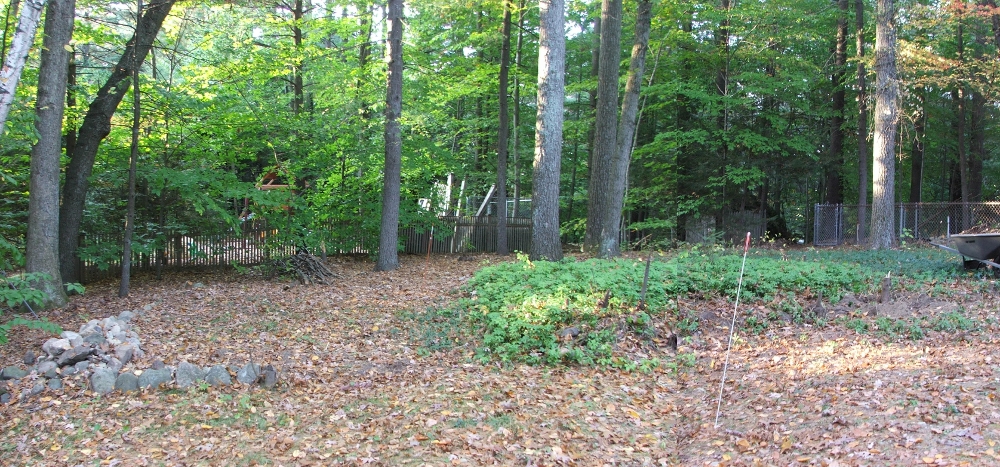 The Pachy Patch in Summer 2008
The Pachy Patch in Summer 2008
yesterday was a perfect summer, spring, winter’s day: cloudless sky, 60F, the mildest of breezes, and some good hard labor. I went out, turned the two defrosted compost bins and then tackled the Pachysandra patch, a.k.a. the vegetable garden. Ah Pachysandra…
It took over five hours of hacking and pulling, getting down on my knees to pull out each and every root and dumping wheelbarrows full of the stuff in our growing “brush” section (or should I compost it? All that green…). In the end my hands were almost no longer up to peeling all that tape off the cardboard boxes. We saved these boxes from our move and big purchases last summer with exactly this in mind: to protect the suddenly exposed soil from the wind and the rain. But the tape was still all over them, so we peeled and cursed as the sun dipped further behind the horizon and a brisk wind came on. We loaded the cardboard with some of the big stones that also came out of the ground. We should have watered them down too, but then it is going to rain and sleet this evening, so why waste tap water?
This now was mostly me, as DH was busy putting out cold frames together. Once in a while Amie would come to help with her little rake, but most of the time she played by all herself in her play set or just exploring the garden, mumbling a a dialogue to herself. I looked over at her often, and knew it in my gut, that that is what we came here for: Amie telling stories in the garden.
So I had time to think, to write stories in my head. There was an incredible clearness that came with the hard work and the cool breeze. I believe it now, that gardener is good for writers, for people in general.
But my particular train of thought was precipitated by a neighbor stopping by to remark: “Mm, Pachysandra. You’ll never get that out, you know.”
“Yeah yeah yeah,” I went in my head after her had left, “did I really need that?” This was followed by retakes of all the avowals, by friends and strangers alike, that this would be difficult, as we have no experience, and it will be very hard work, and we’d get tired before we got anywhere, and did we know what we were getting into, etc. etc.
And then I realized something: how often have I said this? I stood up. How often have I said this not just about our food-project, but about everything else I’ve ever attempted. And not just to myself, but to others, to my friends, my family? Oh, many many times. Because that’s me: the “pessimist” or the “realistic” or “cautious one”.
Why? Because it’s my nature? My upbringing? My culture?
BS!
Then I laughed out loud, the rake (by now one twine was bent up) in one hand, one of those pesky roots in the other. I had just realized something else. You’re going to laugh too, but here goes:
If you are passionate about something, you can do it.
To test this now I rehearsed all the “big projects” I’ve ever worked on. First, my studies in philosophy. Basically I studied philosophy when I was 23 until Amie was born, when I was 34. I earned a Master’s and a PhD, all Summa cum Laude. Then, on the cusp of earning a second PhD, I dropped the whole thing. Why? I’ll tell you why: eleven years of accumulated doubt, most of it self-doubt. I had been passionate about philosophy, in the beginning, but that passion had been slowly eroded away by doubt. Overtaken by a weed.
Second, the novel. I finished that book – baby/toddler in the sling – in a year and a half. Why did this succeed? Because I made short thrift of it. There was very little time for doubt. The idea of not finishing it, of it being hard work never crossed my mind. I just did it. My first agent’s response was a rejection, but it was incredibly encouraging – indeed the best rejection a first-time author could hope for. Once I’ve found the time to follow up on his advice, I could sell the thing.
Listen to me! It’s a new me! The novel has shown me that I can do whatever I set my mind to.
So this garden project now. There are many reasons why I am doing this: food for my family, food for the community, physical and mental health, preparation for an uncertain future, a wholesome life for my daughter… Yes, I know I have no experience. I know there is a lot of shade in my garden. I know it is and will be hard work, and a frost might wipe out all the crops, and our chickens will all eventually die, being animals likes us, and I won’t be able to go on a long holiday in spring, summer or fall. And I will have missed some of this here Pachysandra and it will grow back and I’ll have to weed it again…
I have thought of all these things, you know. And whenever I’ve voiced them to my DH, he said (though maybe not in so many words): So?
And he’s right! I’m not afraid of hard work. I always do my homework. But most of all I’m passionate about this, and no one – least of all me – has the right to trample over it.
Then I said to myself, as I bent to my Pachysandra again, that if this works for me then it will work for others, and I am the first one who should make a change. As of now I will encourage my friends and family no matter what their passion is. I will nudge the doubter aside and say: “Now wait a moment, I can see it in her eye: I have no doubt that she can do it!”
And with that resolution I resumed my hacking away at the last Pachysandra. I could see in that liberated, humusy-dark and lively soil our garden growing.
~
Today it’s coming down, a flurry of almost melting snow on the Pachy Patch in the Winter of 2009:
